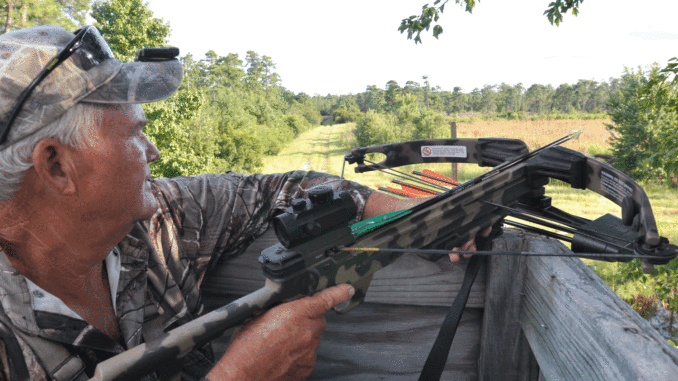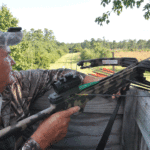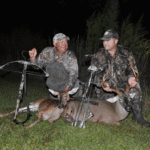
The latest innovations and relaxed hunting regulations are putting more crossbows in the hands of eastern North Carolina deer hunters. Here’s why.
Jerry Simmons of Castle Hayne made his rounds, checking out the ground blinds and elevated stands he and his son Jerry Simmons Jr. were planning to hunt later that afternoon. Instead of avoiding the areas, he was spilling corn from the tailgate of his pickup as it rolled through his Pender County hunting club, Shelter Creek Plantation and Hunting Preserve.
“The deer are used to the traffic and the routine with which I feed my hunting areas,” he said. “We have roads going through the Carolina bays where we hunt, and the stands and blinds are on the roadsides. A deer only has to walk out of the road, and he is hidden in thick cover. He will watch you put down the corn, then come right back out to eat after you leave.”
Simmons, who trains retrievers and pointing dogs, once he used a compound bow only during the archery season. Now, he hunts with a crossbow during the archery season and on Sundays during the muzzleoader and firearms seasons.
“I killed lots of deer with a compound bow,” he said. “I graduated to the compound bow after shooting at a few deer with a recurve bow and never hitting one. Since I’ve switched to a crossbow, I’ve only missed one deer that ducked the arrow after hearing the sound of the crossbow releasing.”
Simmons said several factors were involved in his gravitating to a horizontal bow. One was age. At 64, practicing with a handheld bow had become a chore. Keeping it tuned properly is a problem that persists because he still doesn’t trust his crossbow completely.
“I shoot my crossbow every time I head for the woods,” he said. “It’s usually dead on target, but once a fletching was torn away from the arrow shaft on the leading half inch, and the arrow would not fly true. A little thing like that can cost you a deer.”
Simmons hunts from elevated stands and tent-style ground blinds. One of the advantages of a crossbow is that he can use it from any of the same stands he uses for hunting with firearms.
“With a handheld bow, you have to be able to maneuver the bow into position and draw it, so you need more room in your blinds and stands,” he said. “But you can shoot a crossbow from just about anywhere you can shoot a rifle.”
Simmons said he prefers crossbow hunting from ground blinds. One reason is his age, which makes it more difficult to climb into ladder stands, but his other reasons provide practical advice for anyone who wants to get close enough to send a broadhead through a buck’s vitals.
“With a ground blind, you have a lot more room to maneuver the bow into position, and a deer will never see you move, even if he comes up on your weak side or behind you,” he said. “A ground blind also protects you from the swarms of mosquitoes that live in the swamps. It also keeps off the wind, rain and cold and keeps your scent inside. I’ve had deer come close enough to kill, even when approaching the blind from downwind. I use chemical scent eliminator on my clothing and boots before I walk to my blind and park close enough that I don’t break a sweat.”
The biggest reason Simmons gives for hunting from a ground blind is that the fabric reduces noise. Crossbows generate more sound than compound bows or stick bows, which can make the deer react and move out of the way before the arrow strikes.
“My success rate is much better with a crossbow than with a compound bow,” he said. “I’ve missed only one deer that ducked the arrow from a crossbow at a range of 30 yards when I was hunting from a tree stand. I’ve never had one duck the arrow when I was hunting from a ground blind.”
Simmons and his son, nicknamed “Little Jerry,” hunt together often, especially on Saturdays and Sundays. The privilege of hunting on Sundays was extended to archery hunters three seasons ago.
“We hunt together whenever we can,” the younger Simmons said. “I have a family now, and my work limits my hunting to weekends. I haven’t bought a crossbow yet, but I’m considering changing because I’ve missed a few deer with my compound bow.”
During a hunt last fall, Simmons called his son on his cell phone to tell him he’d arrowed a doe. The response he got was that his son had taken a little buck. But the joke about the “little” buck was as much contrary to the buck’s description as was the nickname, The younger Simmons, half-again as big as his father, he killed a 150-pound buck with an 8-point, 17-inch rack — a great buck for a coastal bay deer.
“I could have arrowed him with a crossbow,” Jerry Simmons Jr. said. “At 20 yards, any archery equipment would have done the job. A doe had come to the corn and wouldn’t eat because she was nervous. The buck that was making her nervous came out of the bushes a few minutes later, more interested in the doe’s scent than in eating the corn.”
Another archer who switched to hunting with crossbows is Chris House of Wilmington, who has killed lots of deer with a compound bow and missed about half as many as he retrieved.
“With a compound bow, I had to practice, practice, practice,” he said. “I still had equipment malfunctions that cost me deer. I had the arrow fall from the rest, once. Another time, I came to full draw and the peep sight was out of alignment with my eye.”
House also cites age — he’s 44 — as the primary reason for selling his compound and buying a crossbow. He is having problems with his eyesight that he did not have when he was younger.
“When you have difficulty seeing your bow sights or the deer, you are going to have difficulty making a good shot, especially under the low-light conditions when you are most likely to see a deer,” he said. “I have a scope mounted on my crossbow, and it has a lighted reticle. When you are hunting with any piece of shooting equipment, you owe it to the game to place the shot as accurately as possible.
“I know hunters who use recurve bows and didn’t want compound bows allowed during bow season because it was not as challenging. I know compound bow users who said the same thing about crossbows, and I understand their point of view. But I wouldn’t hunt without a scope on my rifle, and the same is true of my crossbow.”
House hunts in Pender, Duplin and New Hanover counties, using corn and sweet potatoes for bait. New Hanover has the densest human population of any county in North Carolina, but he is still successful, practically in his backyard.
“I hunt gardens behind people’s houses,” he said. “When I take a deer with my crossbow, it helps out the landowners, and the neighbors never even know I’m there. It’s easier to get permission to hunt with a crossbow than with a gun.”
House has taken some impressive urban bucks with his crossbow. Besides the ability to hunt near homes, another primary reason for his selection of archery gear is limited hunting time.
“Now that I have a child with special needs, I no longer have the time to practice shooting a hand-held bow,” he said. “The fact that I can hunt on Sunday allows me to hunt with archery gear during all deer seasons. My wife spends half a day with my son each Saturday and Sunday, and I look after him the other half days. That gives me two half-days each weekend when I can crossbow hunt. I’m like most hunters who work five days a week. If I couldn’t hunt with a crossbow on Sundays, I might have to give up archery hunting altogether and just hunt Saturdays during the firearms seasons.”
Like Simmons, House gravitates toward ground blinds. He said the ease of taking them down and setting them up and scent control are major factors in switching from ladder and lock-on tree stands. Another reason is that he can set up secondary ground blinds closer to the same bait stations he uses for attracting deer to his rifle stands.
“I’ve never had a deer smell me when I was inside a ground blind,” he said. “I change into a suit of scent-control clothes just before entering the woods and wear rubber boots. I apply scent-control spray before heading into the woods. I only unzip the blind windows necessary for me to see the spots I anticipate getting a shot at a deer. That keeps the wind from blowing all the way through the blind, which would risk taking my scent to the deer and blowing the chance at a shot.”








Be the first to comment